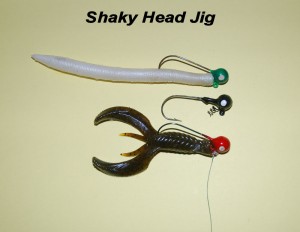Editor’s Note: This column first appeared in The Greater Ashland Beacon on Aug. 10, 2011.
By Chris Erwin
If you follow tournament fishing or read fishing articles, you have likely already heard about the shaky head jig. This simple concept has proven over time to be one of the most productive ways to catch fish in tough times. With summer-time heat driving the surface water temperatures into the high 80s, this is a method that can produce even when the fish seem to have lock-jaw.
Fishing the shaky head is considered finesse fishing opposed to a power or a search method. Many times you know where the fish are, they just won’t take your lure. When you run into this situation the shaky head is a good go to bait.
With this method, it’s best to use light line and spinning gear – six to eight pound test on a six to seven foot medium to light action fast tip rod. This will give you a good setup to take advantage of the strengths of the shaky head.
This jig has a screw made into the head so you can screw the bait down to the ball head holding it secure and preventing it from sliding down the hook. The thin wire hook is then inserted through the body of the bait so the point of the hook is just under the skin of the bait. This makes the lure weedless although the hook can be set with ease.

When fishing any lure, how you present it to the fish is extremely important but it’s paramount when it comes to finesse fishing. This jig is made in many sizes, but I have found that the ¼ oz. is the weight that is most productive. Hook size can very as well but I like a 2/0 or 3/0 depending on the size of worm or creature bait I have paired it with.
After you tie on the bait and snug down your line pull the line to the top of the eye instead of the front of the eye so when you shake the bait it will rock forward and back shaking the plastic offering and giving it life.
Cast the bait letting it sink slowly, keeping your line slack to a minimum. As the bait falls, watch your line. Many strikes occur as the bait is falling. I like to press the line between one finger and the rod base; this improves your ability to detect strikes that may come as a tap-tap feeling. Many fish will simply swim off with the bait. At the first sign of any kind of strike, set the hook.
If and when the bait hits the bottom, take up the slack and gently shake the rod tip. Try not to move the bait a lot, you just want to give life to the bait. Then lift the rod and drag the bait to you with the rod tip, not the reel. Take up the slack and repeat. Once you have moved the bait out of where you think the strike zone is, reel it on in and make another cast.
Give the shaky head a try during tough times, you might just find a new tool for catching fish.
Till next time,
Good Fishing!
Chris Erwin is the founder and publisher of Kentucky Angling News, an outdoor magazine available at www.kentuckyangling.com/magazine. To reach Chris e-mail him at trimmer308@windstream.net.


Be the first to comment